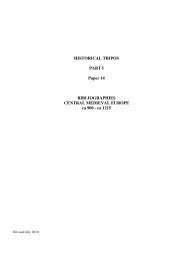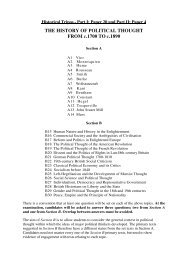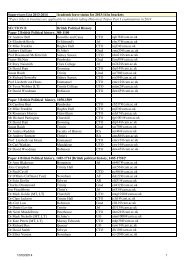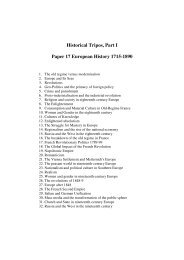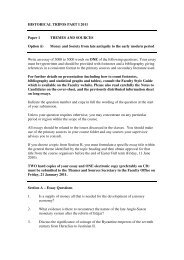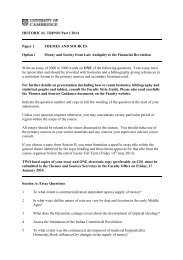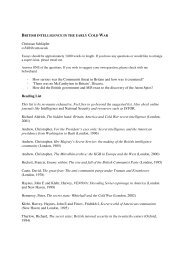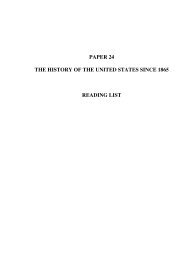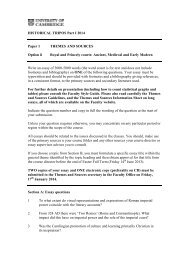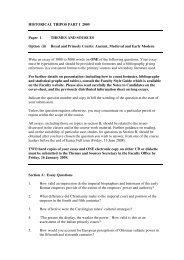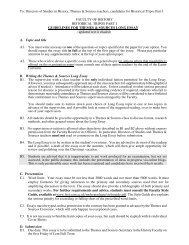Course Handbook - Faculty of History - University of Cambridge
Course Handbook - Faculty of History - University of Cambridge
Course Handbook - Faculty of History - University of Cambridge
You also want an ePaper? Increase the reach of your titles
YUMPU automatically turns print PDFs into web optimized ePapers that Google loves.
APPENDIX C<br />
LENGTH<br />
NOTES ON THE APPROVED STYLE FOR<br />
DISSERTATIONS IN THE HISTORY FACULTY,<br />
CAMBRIDGE<br />
OCTOBER 2010<br />
The dissertation must be between 15,000 and 20,000 words. The word limit includes appendices but<br />
excludes footnotes, references and bibliography. Statistical tables should be counted as 150 words per table.<br />
Maps, illustrations and other pictorial images count as 0 words. Graphs, if they are the only representation<br />
<strong>of</strong> the data being presented, are to be counted as 150 words. However, if graphs are used as an illustration <strong>of</strong><br />
statistical data that is also presented elsewhere within the thesis (as a table for instance), then the graphs<br />
count as 0 words. Only under exceptional circumstances will permission be granted to exceed this limit.<br />
CANDIDATES ARE REQUIRED TO MAKE A WRITTEN DECLARATION INDICATING THE<br />
NUMBER OF WORDS IN THE DISSERTATION AND TO HAVE THIS DECLARATION BOUND<br />
WITH EACH COPY.<br />
TITLE<br />
A title should be brief and to the point. The title should approximate a simple statement <strong>of</strong> the subject or<br />
contents <strong>of</strong> the dissertation. It is advisable to include dates, or some other chronological indication, <strong>of</strong><br />
the time period covered by the dissertation.<br />
BINDING<br />
Dissertations need not be hard bound and spiral binding is acceptable. Essays may be bound, but need not<br />
be.<br />
PLAGIARISM<br />
Board <strong>of</strong> Graduate Studies Statement for graduate students:<br />
In general, plagiarism can be defined as:<br />
the unacknowledged use <strong>of</strong> the work <strong>of</strong> others as if this were your own original work.<br />
In the context <strong>of</strong> an examination, this amounts to:<br />
passing <strong>of</strong>f the work <strong>of</strong> others as your own to gain unfair advantage.<br />
Such use <strong>of</strong> unfair means will not be tolerated by the <strong>University</strong>; if detected, the penalty may be severe and<br />
may lead to failure to obtain your degree.<br />
1 The scope <strong>of</strong> plagiarism<br />
a) Plagiarism may be due to:<br />
• Copying (using another person’s language and/or ideas as if they are<br />
your own);<br />
• Collusion (where collaboration is concealed or has been expressly forbidden, in order<br />
to gain unfair advantage)<br />
b) Methods include:<br />
• quoting directly another person’s language, data or illustrations without clear<br />
26




